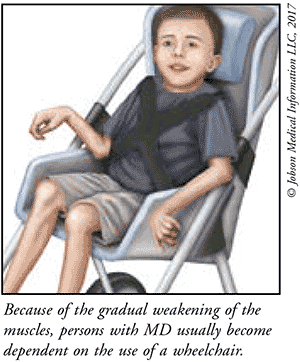US Pharm. 2017;42(1):13.
Muscle Weakness and Wasting
The term muscular dystrophy (MD) describes a group of conditions that affect the body’s muscular and nervous systems. Individuals with MD experience weakness and wasting away of muscle tissue that can occur in different parts of the body, depending on the type of MD. In people without MD, muscle is continually breaking down and rebuilding itself during everyday activities. In those with MD, the problem is twofold: more muscle damage occurs with daily use, and the muscle tissue does not repair itself very well. Because of the buildup of damage, the symptoms of muscle weakness and wasting usually worsen over time.
MD Is Usually Inherited, but It Sometimes Develops Spontaneously
Muscular dystrophy (MD) can occur in individuals of both sexes, any ethnicity, and any age. Of the nine main types of MD, the two that are most common in the United States are Duchenne muscular dystrophy (DMD) and Becker muscular dystrophy (BMD).
Caused by a Genetic Mutation
DMD and BMD occur in approximately 1 in every 7,250 males aged 5 to 24 years. DMD affects mainly boys, starting between 2 and 6 years of age; in rare cases, girls may be affected. BMD is similar, but symptoms can occur later (teens to mid-20s) and progress more slowly. Other types of MD are rare and are defined by a specific feature or the first symptoms that appear. MD is usually passed down genetically; less commonly, there is no family history and the disease develops spontaneously in the womb.

Symptoms and Diagnosis
Symptoms of the most common types of MD usually begin in early childhood, when the child first starts walking. Getting up from the floor, climbing the stairs, keeping balance, or raising the arms becomes a challenge. The physician may perform a series of tests to diagnose MD, including genetic testing and viewing the muscle under a microscope (muscle biopsy). The disease gradually weakens the skeletal, or voluntary, muscles—those in the arms, legs, and trunk of the body. Because of the gradual muscle weakening, persons with MD usually become dependent on the use of a wheelchair. Once a patient is wheelchair-bound, muscle weakening occurs more quickly, resulting in a very poor seated posture. Being hunched over in a chair, unable to stretch and move, makes it harder to fill the lungs and puts a lot of pressure on the heart. Most individuals with MD will die in their 30s or 40s from heart failure or breathing problems.
Treatment: Now and Future
Dystrophin is a protein responsible for the formation of healthy muscle. More than 25 years ago, scientists discovered a dystrophin gene defect that causes DMD. This discovery helped scientists identify possible treatments. There is not yet a cure for MD, so the goal of treatment is to keep MD patients walking, or out of a wheelchair, for as long as possible. Along with regular exercise through physical therapy, pharmacologic strategies slow down the progression of the disease. Muscle strength is maintained with the use of corticosteroids like prednisone, but these drugs can cause significant side effects when used long-term. Potential side effects include weight gain, stunted growth, delayed puberty, weakening of bones, and behavioral problems. Recently, the FDA granted priority review to a new corticosteroid, deflazacort. This new medication may improve muscle strength in DMD patients and cause fewer side effects compared with long-term prednisone use. The FDA will make a decision on deflazacort in February 2017.
Experimental treatments to correct or reduce the effects of the dystrophin gene defect that occur in DMD are in development. On September 20, 2016, the FDA granted accelerated approval for eteplirsen, the first drug to treat the cause of DMD. This accelerated approval gives patients earlier access to the drug, but the drug manufacturer must prove that eteplirsen improves muscle wasting and weakness in DMD patients.
Your local pharmacist is here to help. If you, a friend, or a family member has questions about medications used for MD, ask a trusted pharmacist or other healthcare provider.
To comment on this article, contact rdavidson@uspharmacist.com.






